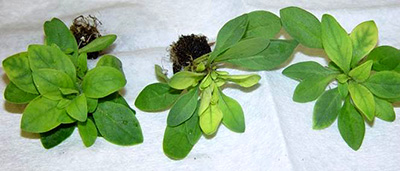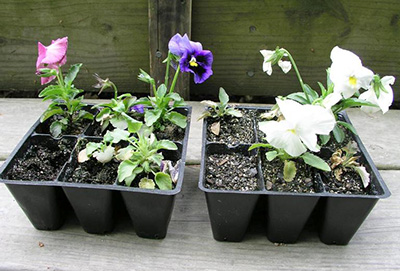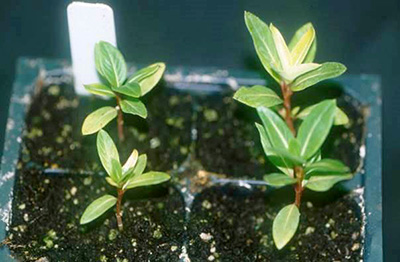Thielaviopsis symptoms and control
Greenhouse and nursery growers should know the symptoms of black root rot when scouting their spring bedding plants.

Growers need to keep an eye out for black root rot (Thielaviopsis basicola) in the following crops that are most susceptible: petunia, calibrachoa, vinca and pansy. Thielaviopsis root rot is often misdiagnosed by growers as a nutrient management problem or another root rot disease. Michigan State University Extension recommends submitting a sample to the MSU Plant Diagnostics Lab prior to choosing a disease management product.
Symptoms
Symptoms include chlorotic lower foliage, poor rooting, lack of growth, wilting, blackening of roots, rotted root hairs and secondary roots.

Black root rot on petunia. Photo by Blair Harlan, MSU

Black root rot on pansy. Photo by Bruce Watt, University of Maine, Bugwood.org

Black root rot on vinca. Photo by Blair Harlan, MSU
Diagnosis
The symptoms of black root rot are similar to that of other root rots. Therefore, we recommend you send your plants to a diagnostics lab to verify the root rot infecting your plants.
Management
If a grower receives confirmation that plants in their greenhouse are infected with Thielaviopsis, growers should first throw out all plants exhibiting symptoms and continue scouting the neighboring plants for symptoms of the root rot. Thielaviopsis is spread by splashing water from infected plant material and by fungus gnats and shore flies. Growers should minimize splashing and tight-spacing of plants. Elevating the plants that are grown on the ground off of the black mat will prevent further spread of the disease.
As Thielaviopsis produces a type of resting spore, chlamydospores, sanitation will be extremely important during the growing season when it has been detected. Irrigation equipment, benches, floors and mats should be regularly sanitized with products such as quaternary ammonium (e.g., Green Shield) or hydrogen dioxide (e.g., ZeroTol).
Growers will also need to treat uninfected neighboring plants with a fungicide to prevent the spread of the black root rot. According to MSU Extension’s 2016 disease management recommendations, the following products should be applied at their high label rates: thiophanate-methyl (e.g., Clearys 3336/OHP 6672), triflumizole (e.g., Terraguard SC/LS) or fludioxonil (e.g., Medallion).
Growers should also implement an insect management program for fungus gnats and shore flies as they can spread the disease. For those using biological control, we recommend beneficial nematodes (Steinernema feltiae; apply 50 million nematodes per 1,000 square feet as a drench), predatory rove beetle (Dalotia coriaria; one rove beetle adult per 10 square feet) or predatory mites (Stratiolaelaps scimitus; release 1,000 to 2,000 predatory mites per square foot).
For growers using biorational or conventional insecticides, we recommend the following products as a soil drench: azadarachtin products, diflubenzuron (Adept), cyromazine (Citation), pyriprosxyfen (e.g., Distance, Pyranica, or Engulf) or a neonicotinoid (e.g., imidacloprid).
For more information on black root rot on pansy, check my recent e-GRO alert, “Black Root Rot on Pansy…Keep Looking at Those Roots.” For more information about black root rot on other crops, check out another e-GRO alert, “Spring Thielaviopsis? Look To Your Roots!”



 Print
Print Email
Email




